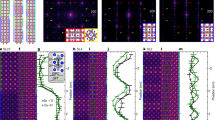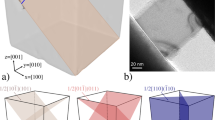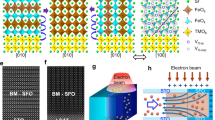Abstract
Determining how thermal vacancies are created and destroyed in solids is crucial for understanding many of their physical properties, such as solid-state diffusion. Surfaces are known to be good sources and sinks for bulk vacancies, but directly determining where the exchange between the surface and the bulk occurs is difficult. Here we show that vacancy generation (and annihilation) on the (110) surface of an ordered nickel–aluminium intermetallic alloy does not occur over the entire surface, but only near atomic step edges. This has been determined by oscillating the sample's temperature and observing in real time the response of the surface structure as a function of frequency (a version of Ångström's method of measuring thermal conductivity1) using low-energy electron microscopy. Although the surface-exchange process is slow compared with bulk diffusion, the vacancy-generation rate nevertheless controls the dynamics of the alloy surface morphology. These observations, demonstrating that surface smoothing can occur through bulk vacancy transport rather than surface diffusion, should have important implications for the stability of fabricated nanoscale structures.
This is a preview of subscription content, access via your institution
Access options
Subscribe to this journal
Receive 51 print issues and online access
$199.00 per year
only $3.90 per issue
Buy this article
- Purchase on Springer Link
- Instant access to full article PDF
Prices may be subject to local taxes which are calculated during checkout



Similar content being viewed by others
References
Ångström, A. J. New method of determining the thermal conductibility of bodies. Phil. Mag. 25, 130–143 (1863).
Herring, C. in Structure and Properties of Solid Surfaces (eds Gomer, R. & Smith, C. S.) (Univ. Chicago Press, 1952).
Mullins, W. W. Flattening of a nearly plane solid surface due to capillarity. J. Appl. Phys. 30, 77–83 (1959).
Bauer, E. Low-energy-electron microscopy. Rep. Prog. Phys. 57, 895–938 (1994).
Jeong, H. C. & Williams, E. D. Steps on surfaces: experiment and theory. Surf. Sci. Rep. 34, 175–294 (1999).
Giesen, M. & Ibach, H. Step edge barrier controlled decay of multilayer islands on Cu(111). Surf. Sci. 431, 109–115 (1999).
Ibach, H., Giesen, M., Flores, T., Wuttig, M. & Treglia, G. Vacancy generation at steps and the kinetics of surface alloy formation. Surf. Sci. 364, 453-466 (1996).
Bradley, A. J. & Taylor, A. An X-ray analysis of the nickel–aluminium system. Proc. R. Soc. Lond. A 159, 56–72 (1937).
Wasilewski, R. J. Structure defects in CsCl intermetallic compounds—I theory. J. Phys. Chem. Solids 29, 39–49 (1968).
Hagen, M. & Finnis, M. W. Point defects and chemical potentials in ordered alloys. Phil. Mag. A 77, 447–464 (1998).
Korzhavyi, P. A. et al. Constitutional and thermal point defects in B2 NiAl. Phys. Rev. B 61, 6003–6018 (2000).
Meyer, B. & Fahnle, M. Atomic defects in the ordered compound B2-NiAl: A combination of ab initio electron theory and statistical mechanics. Phys. Rev. B 59, 6072–6082 (1999).
Meyer, B. & Fahnle, M. Atomic defects in the ordered compound B2-NiAl: A combination of ab initio electron theory and statistical mechanics [(Phys. Rev. B 59, 6072 (1999)]. Phys. Rev. B 60, 717–717 (1999).
Mishin, Y. & Farkas, D. Atomistic simulation of point defects and diffusion in B2 NiAl. 1. Point defect energetics. Phil. Mag. A 75, 169–185 (1997).
Davis, H. L. & Noonan, J. R. Rippled relaxation in the (110) surface of the ordered metallic alloy NiAl. Phys. Rev. Lett. 54, 566–569 (1985).
Bai, B. & Collins, G. S. in High-Temperature Ordered Intermetallic Alloys VII, MRS Symposia Proceedings No. 552 (eds George, E. P., Yamaguchi, M. & Mills, M. J.) KK8.7.1 (Materials Research Society, Pittsburgh, 1999).
Smirnov, A. A. Anomaly in the temperature dependence of the vacancy concentration in NiAl type alloys. Sov. Phys. Dokl. 36, 479–480 (1991).
Zinke-Allmang, M., Feldman, L. C. & Grabow, M. H. Clustering on surfaces. Surf. Sci. Rep. 16, 377–463 (1992).
Tanaka, S., Bartelt, N. C., Umbach, C. C., Tromp, R. M. & Blakely, J. M. Step permeability and the relaxation of biperiodic gratings on Si(001). Phys. Rev. Lett. 78, 3342–3345 (1997).
Blakely, J. M. Effect of impurity on surfaces of heated gold. Trans. Faraday Soc. 57, 1164–1168 (1961).
Maiya, P. S. & Blakely, J. M. Surface self-diffusion and surface energy of nickel. J. Appl. Phys. 38, 698–704 (1966).
Hoehne, K. & Sizmann, R. Volume and surface self-diffusion measurements on copper by thermal surface smoothing. Phys. Status Solidi A 5, 577–589 (1971).
Acknowledgements
This work was supported by the Office of Basic Energy Sciences, Division of Materials Sciences of the US Department of Energy. We thank D. C. Dibble, N. Y. C. Yang and K. J. Gross for technical assistance and B. Poelsema, J. C. Hamilton, J. J. Hoyt, J. B. Hannon, P. J. Feibelman and G. E. Thayer for discussions.
Author information
Authors and Affiliations
Corresponding author
Supplementary information
Movie 1
A video (Quicktime format) example of isothermal island decay on the NiAl (110) surface at 985°C. The imaged structure consists of a stack of islands, just like a tiered wedding cake. The dark lines in the low-energy electron microscopy (LEEM) images mark the surface steps, at which the height changes by one atomic layer between the atomically flat terraces. Thus the images are analogous to a topographic map with the steps corresponding to contours of constant elevation. Remarkable behavior is obvious in the movie -- all the islands are shrinking at once and at the same rate. Thus there is no evidence for mass being transported from the islands of highest curvature (the upper islands) to regions of lower curvature (the lower islands). While not shown, we also observe that adjacent islands of different size (radius of curvature) on the same terrace shrink at the same rate. That is, Ostwald ripening, where small (high chemical potential) islands shrink giving their mass to large (low chemical potential) islands, is also not occurring. The independence of the decay (smoothing) rate on the environment for both stacked and adjacent islands directly establishes that a surface diffusion process is not operative. The field of view is 5.8 x 5.8 μm2 and the elapsed time is 6.7 minutes.
Movie 2
A video (Quicktime format) example of what oscillating the sample temperature between 770 and 785°C does to surface morphology. The bar graphs show the sample temperature and area of the island topmost in the stack, respectively. As the temperature increases (decreases), the island area increases (decreases) by an amount strictly proportional to the step length of the island. These oscillations are superimposed upon a slow shrinkage of the island due to thermal smoothing. About half way through the movie, a dislocation (marked by the terminating surface step) moves into the field of view. While altering the local step configuration, the dislocation does not affect either the slow thermal smoothing or the size of the more rapid area changes. While the temperature oscillations of this example are quite small, larger temperature oscillations bring multiple layers to and from the surface (see Movies 3 and 4). The field of view is 3.9 x 3.6 μm2 and the elapsed time is 38 minutes.
Movie 3
A video (Quicktime format) example of what a large temperature increase does to the NiAl surface morphology. Over about 10 seconds, the NiAl crystal was heated from 924 to 1025°C. The field of view is 5.75 x 5.75 μm2. Individual images from this movie are shown in Fig. 1.
Movie 4
A video (Quicktime format) example of what a large temperature decrease does to the NiAl surface morphology. Over about 2 minutes, the NiAl crystal was cooled from 958 to 740°C. Since the thermal smoothing is slow on this time scale, nearly all the mass removed from the surface results from the temperature change. The field of view is 5 x 5 μm2. Individual images from this movie are shown in Fig. 2.
Rights and permissions
About this article
Cite this article
McCarty, K., Nobel, J. & Bartelt, N. Vacancies in solids and the stability of surface morphology. Nature 412, 622–625 (2001). https://doi.org/10.1038/35088026
Received:
Accepted:
Issue Date:
DOI: https://doi.org/10.1038/35088026
This article is cited by
-
Subsurface diffusion in crystals and effect of surface permeability on the atomic step motion
Scientific Reports (2019)
-
Synthesis of advanced aluminide intermetallic coatings by low-energy Al-ion radiation
Scientific Reports (2016)
-
Wafer Mapping Using Deuterium Enhanced Defect Characterization
Journal of Electronic Materials (2010)
-
Surface segregation of the metal impurity to the (100) surface of fcc metals
Pramana (2007)
-
Dislocation-driven surface dynamics on solids
Nature (2004)
Comments
By submitting a comment you agree to abide by our Terms and Community Guidelines. If you find something abusive or that does not comply with our terms or guidelines please flag it as inappropriate.



